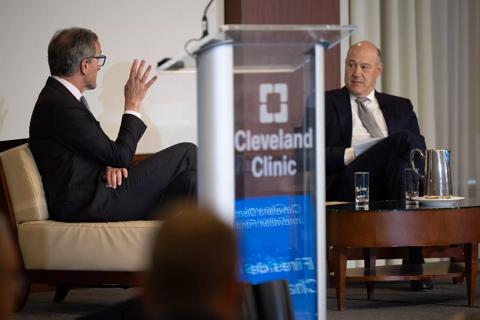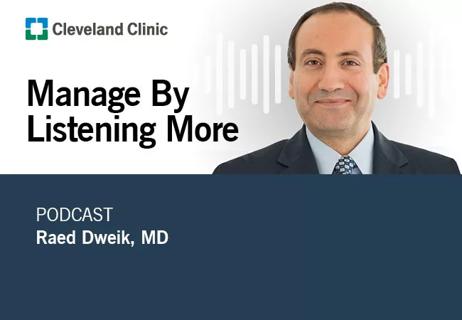Advertisement
New care paths focus on value and operationalizing care

Advertisement
Cleveland Clinic is a non-profit academic medical center. Advertising on our site helps support our mission. We do not endorse non-Cleveland Clinic products or services. Policy
Ask any provider practicing in the United States what most concerns him or her about the future of healthcare, and the answer is likely to be managing the transition to a value-based care system.
Reimbursement in the United States has been based on volume and focused on procedures and acute care delivery. Providers have had little incentive to reduce utilization or improve outcomes and actually are sometimes rewarded for increasing utilization, as reimbursement has been based solely on the number of encounters or procedures. Now, however, both private and federal payers are slowly changing this reimbursement structure to reward providers based on outcome and quality measures instead of volume.
With the advent of accountable care organizations, risk-based contracting and federal value-based purchasing programs, changes in the reimbursement and practice of medicine have begun to materialize, and many more are on the way.
At Cleveland Clinic Children’s, we have recognized this impending sea change and are taking steps to be leaders in the delivery of value-based care for children across the nation. One of our first steps has been to embark on the creation of standardized care paths.
Cleveland Clinic Care Paths are evidence-based algorithms embedded within our electronic health record (EHR) system that guide providers and patients through episodes of care for a specific disease state. They are more than just sets of practice guidelines but are instead electronic tools built on top of guidelines to help providers make guidelines operational.
The more than 50 care paths in development or completed across all of Cleveland Clinic represent an opportunity to reduce variation in clinical care (including in utilization and cost) while maintaining or improving outcomes. This requires a significant change in the nationally ubiquitous culture in which each physician, division and department has operated independently of all other contingent systems within an organization.
To accomplish this change, Cleveland Clinic Children’s leadership has created a series of multidisciplinary teams led by physician champions within each of several targeted disease states to create an initial guide detailing a needs assessment and best practices.
These guides are then reviewed by individuals from stakeholder areas, including nursing, quality and patient safety, patient experience, and compliance, as well as from ancillary services such as finance, radiology, laboratory medicine and pharmacy. Cleveland Clinic Children’s now has care paths under development for the following:
• Diagnosis and management of hyperbilirubinemia in term neonates
• Inpatient asthma care
Advertisement
• Care of inpatients with diabetic ketoacidosis
After completing these care path guide documents, the work team that creates the guide partners with a multidisciplinary technical team to translate the documents into electronic tools. There are front-end user tools such as standardized documentation templates, order sets, and clinical decision-support and predictive analytical tools that assist providers in delivering care according to standards set forth in the guide (see sidebar for example).
Additional reporting tools are developed to monitor performance of physicians and facilities in meeting the guide’s standards. Finally, condition-specific outcome metrics are collected and reported for individual physicians, divisions, departments and facilities. An overarching steering committee has been formed to regularly review the performance data and ensure that performance goals are being met, to identify best practices, and to assist groups encountering operational challenges.
A tool for the long haul
Cleveland Clinic Children’s leadership believes these standardized Cleveland Clinic Care Paths present multiple opportunities for long-term strategic success. Experience with optimization of EHR tools and performance measurement strategies will reduce unnecessary variation in care while driving best practices through increased transparency and accountability.
This initiative also offers a rare opportunity for outcomes-based research in a real-world clinical setting. Most important, families can be assured they will receive the same level of care at all our facilities, regardless of provider or location.
We believe care paths are an essential step toward improved patient and family satisfaction and consistently good clinical outcomes for patients. As our experience expands, these documents and tools should provide invaluable insights and guidance for our health system as we navigate the transition from volume-based to value-based care.
Dr. Spalding, Director of the Center for Pediatric Rheumatology, is overseeing Cleveland Clinic Children’s care path development efforts.
Advertisement
Advertisement

Interactive Zen Quest experience helps promote relaxing behaviors

Cleveland Clinic and IBM leaders share insights, concerns, optimism about impacts

Cleveland Clinic partners with Palantir to create logistical command center

A Q&A with organizational development researcher Gina Thoebes

Cleveland Clinic transformation leader led development of benchmarking tool with NAHQ

Raed Dweik, MD, on change management and the importance of communication

Small business owners expand their networks and gain new insights

Leadership pearls from Margaret McKenzie, MD, hospital vice president